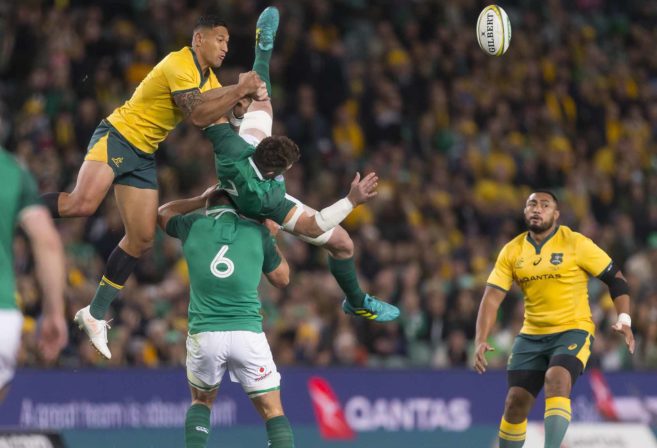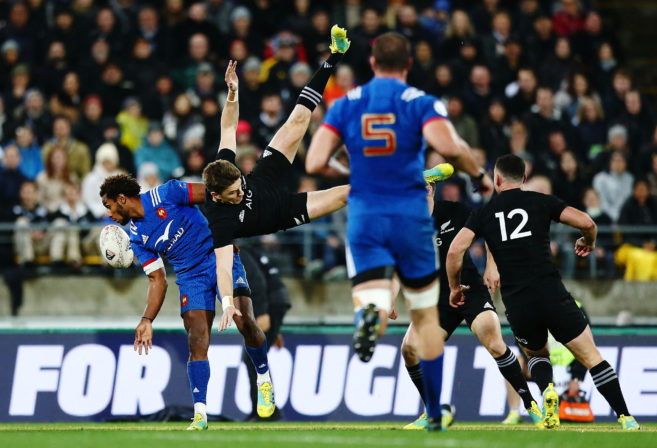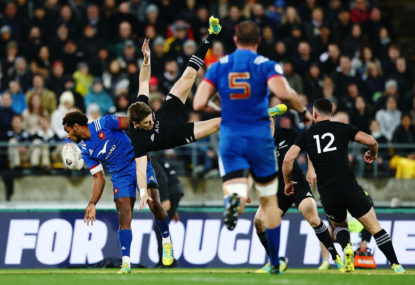To mangle a quote attributed to Mark Twain, reports of rugby’s death have proven to be greatly exaggerated.
Round 17 of Super Rugby threw up enough surprise results and brilliant individual performances to keep the great game alive for at least another week, despite obituaries shouted by outraged fans and commentators – some of whom really should know better.
To be clear; rugby is still ‘the game they play in heaven’, not ‘the game that died and went to heaven.’
Pity thus the Twitter merchants who proclaimed with each intervention of TMO Ben Skeen, ‘That’s it for rugby. I’m out. I’m done. Done.’ No more for them the silky running of Solomona Alaimalo and Bautista Delguy, the blistering gallop of Jaguares big-man Guido ‘Tom’ Petti, the insistence of Tom Cusack to put his body on the line for his team’s cause, the rubber-band qualities of the Sunwolves, or the peerless trip down memory lane from Liam Messam.
Not to mention a try of such stunning and audacious brilliance by TJ Perenara it had everyone who saw it assuming he must have been offside, when he wasn’t.
To deny that rugby is going through a rough patch is a bit like pretending that America has nailed gun control. Conflicting objectives like player safety and the retention of rugby’s ‘contest for the ball’ essence are making for uneasy bedfellows. The availability and use of technology, the increased athletic ability of players, and the ability of World Rugby to frame and administer laws to keep up with a rapidly evolving game, all add fuel to a complex fire.
But when the outrage from commentators – many of whom are ignorant of the laws of the game – is stripped back, what is exposed are problems that are not an existential threat to the sport at all, but merely another set of challenges for the game in line with many that have gone before it.
Find any New Zealand rugby fan old enough to remember when milk was delivered by truck and having a ‘Gaytime’ didn’t require a national referendum, drop the name ‘Bob Deans’, and observe the reaction. Or consider how the 1960s and 70s were marked by all rugby nations struggling to cope with ‘hometown’ refereeing, with accusations of cheating flying across the news wires north and south, east and west.
Into the 1980s, the argument shifted slightly, from an issue of partiality to one of interpretation. Northern Hemisphere referees blowing the pea out of the whistle to stymie Southern Hemisphere nations who wanted to play ‘real’ rugby; and vice-versa, northerners complaining of southern referees ignoring the law book.
Andre Watson versus George Gregan in the early 2000s, Wayne Barnes in 2007, Craig Joubert in 2015. And not just in rugby too. For many, Australia’s 2018 Football World Cup finals campaign was cruelled from the start by dubious application of the VAR system. And this NRL season has been littered with complaints about how refereeing interpretations are ‘killing the game’.
Sound familiar?
The truth is, rugby is no different to any other sport, but with the outrage meter currently stuck on extreme, how can rugby pick its way through this current malaise?
The first requirement is recognition and reinforcement that the game of rugby, its law-setting and application of those laws, are a global proposition. This is useful because it requires that people in pockets of discontent slow down and draw breath, and understand that their problems and solutions are matters for the whole game, and it also demands that World Rugby own the situation, and finds the means to provide solutions in a timely manner – no bad thing.
Secondly, actual problems must be clearly defined. Is the pressing issue that an athlete with the vertical leap of Israel Folau be allowed to compete for the ball in the air, without fear of being banished from the game? Or is the key issue the consistent interruption to the game by overzealous TMOs?

(AAP Image/Craig Golding)
Is player safety the main concern? Or is it ensuring the longevity of the sport by making the game more attractive – whatever that actually means? Or making rugby less threatening for parents considering whether they allow their children to play or not? Or is it more important that the brandishing of yellow and red cards aren’t allowed to ‘ruin’ a match?
Perhaps, in order to encapsulate all of these matters into one, are we better to ask, are the laws of rugby fit for purpose?
The outraged or cynical may disagree but World Rugby’s lawmaking process is by no means an afterthought, and many good rugby men have invested thousands of hours into devising a modern law book that – for the most part – serves the game well.
But what is different in 2018 is that:
1. Aspects of the game are evolving faster than the lawmaking and review process, and
2. The advent of technology – introduced to provide more certainty – is in fact proving discordant when applied to a law book whose interpretation has always required, and continues to require, subjective interpretation.
While there are amendments made and guidelines introduced on a regular basis, for the game to remain cohesive laws cannot be added willy-nilly so as to introduce unintended consequences, and simply shift a problem to somewhere else.
So while specific issues need to be dealt with as they arise – in the current climate, let’s say the matter of players contesting the ball in the air – the underlying principle must be that each individual law must reflect an objective that consistently underpins the whole lawbook.
To use an example, those who say things like, ‘I understand the need for safety and all that, but Folau must be allowed to jump and compete for the ball and if there is a collision that’s just part of the game’, don’t actually understand this point at all. They are ‘cherry picking’ and do not truly recognise what is at the heart of the safety concerns.
[latest_videos_strip category=”rugby” name=”Rugby”]
At the most fundamental level, rugby’s lawmakers have to determine what is an acceptable level of risk of injury for players, and what elements of the game must be preserved at all costs, so as for rugby to retain its essence as the game that we know and love.
To date, rugby has managed to do this reasonably well. A spate of life-changing spinal injuries in the 1980s was met with a range of law changes, technique and coaching measures that – while not eliminating danger entirely – has made the sport inherently safer, without detracting from its essence.
More recently, protocols have been introduced that have improved recognition of and behaviour around concussion issues. These have been accompanied by attitude changes at all levels of the game that indicate that rugby people do have the ability to shift with the times, for the better, when the situation demands it.
The piece that has largely been missed in the current debate is a specific determination of what type of injury is an acceptable risk. Using examples from the weekend, I’d argue that TMO intervention against the Waratahs’ Bernard Foley and the Reds’ Taniela Tupou was unwarranted.
Tupou made a clumsy looking tackle, but it did involve the use of an arm, it wasn’t potentially dangerous, nor was there a deleterious outcome for an opponent; while in Foley’s case, the Rebels’ Anaru Rangi slipped over entering contact, and hit his head on Foley’s shoulder.
These are the types of things that happen on a rugby pitch that may or may not result in injury, that are part and parcel of the game, and represent an acceptable level of risk. They most certainly do not justify the continuity of the game being interrupted.
On the other hand, Reds winger Jordan Petaia lifted Blues fullback Michael Collins, tipped him past horizontal, and while he didn’t continue on and drive Collins into the ground, Collins was only prevented from landing on his head or neck because he happened (by chance) to have an arm free to break the fall. Petaia’s yellow card was entirely justified.
The key difference in these examples – and in the case of Peter O’Mahoney and Beauden Barrett being concussed in the June internationals – is that the potential for head, neck and spinal injuries must never be an acceptable level of risk.
Yes, rugby is a hard man’s game and long may it remain so. An argument exists that foul play should be adjudicated on the basis of how foul the intent is, not how foul the outcome is. Applied generally, that is a fair objective, but in our society we are rightly held culpable for serious actions (say a motor vehicle accident causing the death of someone else), regardless of intent.

(Photo by Anthony Au-Yeung/Getty Images)
Despite the Benjamin Fall/Barrett incident, and setting aside arguments about whether Fall was impeded or not, players, coaches and referees have adjusted well to situations regarding the catching of high kicks. For the amount of rugby played, and number of kicks made, incidents are few, and most players now inherently know when it is safe and lawful to jump and attempt a catch, or when to hang back and tackle the catcher once he has landed safely.
Folau’s case is problematic because it involves a rare case of an athlete of exceptional leaping ability, it involves a set-piece maneuver, and it introduces the concept of players being lifted in the air and their culpability. It is as if everything about these situations is set-up to almost guarantee a dangerous or controversial outcome.
It may well be that lifting of players except at line-out will be outlawed as part of a review; which would of course only make it more enticing for Australia to use Folau as a leaping weapon from kick-offs, potentially posing even greater risk of chaos and injury as he soars above the shoulders and flailing arms of defenders.
In any event, it is highly probable that the existing law has it about right. Except in an obvious case, there is little hope of a referee or TMO accurately adjudicating in real time, any potential level of liability for the lifter, particularly once the player he is holding is bumped in any way.
As long as all competing players grab for the ball and keep their hands off each other while in the air, then it is ‘play on’. But either player grabbing at the opponent’s body must open them up to (an outcomes-based) sanction.
If it proves too difficult for Folau to ensure that he can’t compete without infringing in this way, and he is thus discouraged from repeating the action, then so be it.

(AAP Image/Dave Hunt)
If that, or a side going a man down, is the price paid to prevent a serious head, neck or spinal injury, it is a price worth paying.
With respect to technology, television reviews are helpful when matters are absolute. Tennis is the shining example; is the ball in or out? One look, yes or no, move it along. Rugby’s closest equivalent might be a winger planting the ball down in the corner; did he step on the touch-line or not? The game is the better for taking the guesswork out of these situations and getting these calls (overwhelmingly) right.
The existence of the TMO is also a powerful deterrent against foul and/or dangerous play off the ball. No serious rugby person would welcome a return to the days of thuggery and ‘street justice’ that would inevitably follow the abolition of the TMO for detecting and ruling on such matters.
But greater refinement is needed. Often it is not clear who exactly is in charge. In the third Test between New Zealand and France, referee John Lacey asked a specific question of TMO George Ayoub that Ayoub ignored, instead providing his own ruling.
In the first Australia versus Ireland Test, TMO Skeen ruled a no-try against Ireland using vision that only he had access to – while referee Marius van Der Westhuizen, the players, and hundreds of thousands of viewers looked on, bemused.
The NRL’s ‘bunker’ has taken some time to bed down, but the speed at which decisions are now made, the consistency in the decision-making process, and the clarity around what it is and isn’t used for, must surely have piqued World Rugby’s interest.

While passion is a key element in rugby, it is useful to set emotion aside for a moment, in order to confirm an appropriate framework by which the game can be administered, played and enjoyed.
This can be captured broadly in four aspects:
- World Rugby ensuring that the laws of rugby are underpinned by the determination and reinforcement of what are unacceptable levels of risk (head, neck and spinal injuries), and that within this constraint, the essence and ethos of rugby as a contest for the ball is maintained
- That laws and their periodic amendments are communicated clearly and widely so that all participants in the game understand their intent and application
- That, allowing for the subjectivity of elements of decision making, laws are applied consistently and without contradiction by suitably trained and rugby empathetic referees, TMOs and judiciary officers
- That administrators, coaches, players, media commentators and fans take it upon themselves to fully understand the laws of the game, their intent and application, the subjective nature of their application, and stop being outraged and get on with the game.

































































































